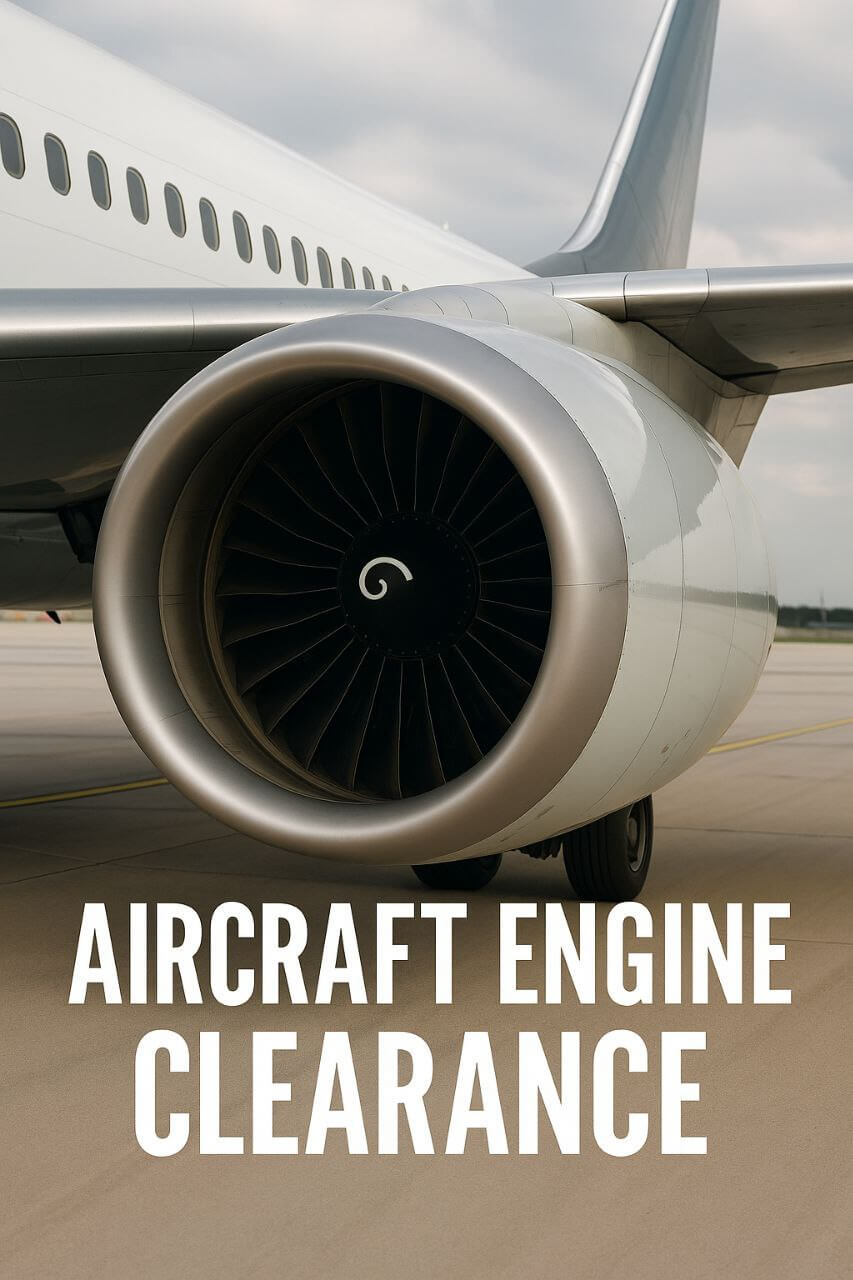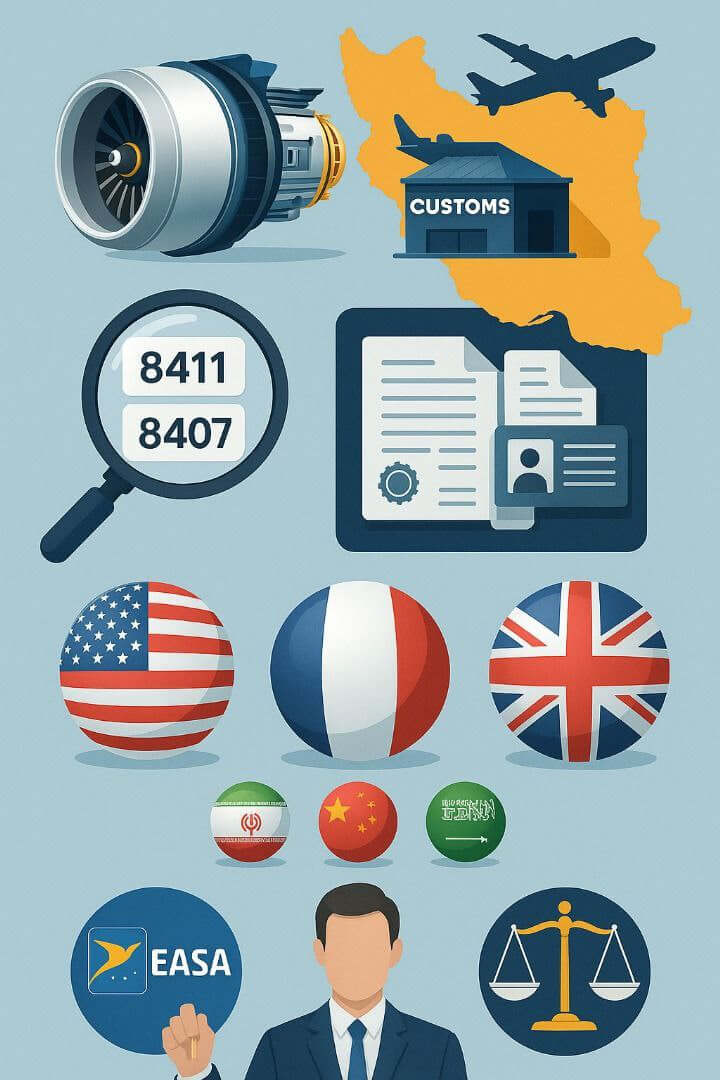Customs Clearance of Aircraft Engines in Iran (HS + Documents and Permits)

For an estimate of time and cost for clearing aircraft/helicopter engines (reciprocating, turbine, jet, rocket), contact the experts at Saba Tarkhis.
Immediate Free Consultation1) Types of Aircraft Engines
Turbine Engines: These come in several categories and are widely used in airplanes and helicopters. Subtypes include:
Turbojet: The first type of turbine engine, used in high-speed aircraft like fighter jets and early passenger planes. Operation is based on air compression in the compressor, fuel combustion in the combustion chamber, and expulsion of hot gases at high speed from the nozzle, generating thrust. Turbojets are still used in military and some commercial aircraft due to their high efficiency at high speeds and altitudes.
Turbofan: Widely used in modern passenger aircraft, combining a large fan at the front with the turbine. This design increases efficiency and reduces fuel consumption and noise. Turbofans perform better at subsonic speeds, making them the engine of choice in most commercial and military aircraft.
Turboprop: Designed for regional and short-haul aircraft, where a turbine drives a propeller. Turboprops are highly efficient at low to medium speeds, offering a cost-effective alternative for short routes.
Turboshaft: Mainly used in helicopters and VTOL aircraft, these engines deliver mechanical power directly from the turbine to the output shaft, providing the power needed to rotate helicopter rotors.
Jet Engine: A turbine engine capable of producing high thrust at high speeds and altitudes, widely used in fighter jets and high-speed commercial aircraft. They compress air, combust fuel, and expel hot gases at high speed, generating tremendous thrust. While highly efficient at supersonic speeds, their high fuel consumption limits them to specific applications.
Rocket Engine: Among the most powerful propulsion systems, used mainly in spacecraft and missiles. Unlike other engines, rocket engines use onboard fuel and oxidizer and can operate in space vacuum. They generate immense thrust, enabling launches into space, but are costly to build/maintain and consume fuel rapidly.
2) Technical Notes on Aircraft Engine Clearance
Reciprocating Engines: Classified under HS Code 8407.
Turbine and Jet Engines: Classified under HS Code 8411. Accurate knowledge of these codes is essential for calculating duties, taxes, and tariffs, directly impacting total import costs.
Import Permits and Standards: Due to their critical role in flight safety and strict standards, importing aircraft engines requires special permits from regulatory bodies. These include technical approval certificates from the Civil Aviation Organization, Ministry of Defense, and international standardization bodies like EASA (European Union Aviation Safety Agency) and FAA (Federal Aviation Administration). Any technical non-compliance can result in shipment rejection or seizure at customs.
| Engine Type | Application/Description | HS Code |
|---|---|---|
| Reciprocating | Light/training aircraft; propeller-driven | 8407 |
| Turbine/Jet | Turbofan/Turbojet/Turboprop/Turboshaft | 8411 |
Exact classification depends on power (kW/lbf), application (Fixed/Rotary/VTOL), new/used, and component/module condition.
3) Exporting and Importing Countries of Aircraft Engines
United States: With manufacturers like General Electric (GE) and Pratt & Whitney
United Kingdom: With Rolls-Royce
France: With Safran and Snecma
Germany: With MTU Aero Engines
Canada: With Bombardier and others. These producers dominate global exports through continuous innovation.
Importing countries: Vary depending on industrial, military, and aviation needs. For example:
Middle East: UAE, Saudi Arabia, and Iran import engines to modernize fleets and expand aviation infrastructure.
Eastern Europe and Central Asia: Also contribute to demand due to expanding aviation and defense industries.
4) Permits, Standards, and Legal Considerations
Need HS 8411/8407 classification, Civil Aviation Organization and EASA/FAA approvals? Our team handles the entire process.
Submit Proforma Request
Frequently Asked Questions
What is the HS Code for aircraft engines?
Reciprocating engines fall under 8407 and turbine/jet engines under 8411. Final classification depends on power, condition, and application.
What permits are required for importing aircraft engines?
Approvals from the Civil Aviation Organization, defense-related permits (if applicable), and compliance with EASA/FAA and Iranian National Standards.
Is it possible to import used aircraft engines?
Yes, provided there is technical approval, maintenance/overhaul records, and specific permits from competent authorities.
Multimedia Suggestions
- Image file name:
aircraft-engine-customs-clearance-iran-8411-8407.jpgCustoms Clearance of Aircraft Engines | HS 8411/8407, Documents, Permits, and StandardsCustoms Clearance of Aircraft Engines from Iranian Customs (HS + Documents and Permits)
An aircraft engine, also called an airplane engine, is one of the key components in the aviation and aerospace industry, responsible for providing thrust. These engines are produced in various types, and each, depending on the type of aircraft and its mission, has different structures and performance. The types include reciprocating engines, turbine engines, jet engines, and rocket engines. Each of these engines has specific features and applications, which we will examine in more detail below.For an estimate of time and cost to clear aircraft/helicopter engines (reciprocating, turbine, jet, rocket), contact the experts at Saba Tarkhis.
Immediate Free Consultation1) Types of Aircraft Engines
Reciprocating Engine: Reciprocating engines are among the oldest and best-known aircraft engines, mainly used in light and training aircraft. In a reciprocating engine, fuel combustion (usually gasoline or aviation fuel) inside the cylinders causes the pistons to move back and forth. This motion is converted into rotational motion via the crankshaft, providing the driving force to turn the propeller. One advantage is simpler design and lower production and maintenance costs compared to other types. However, limitations such as lower efficiency and limited power relative to turbine engines restrict their use to light, short-range aircraft.
Turbine Engine: Turbine engines fall into several categories and are used across a wide range of airplanes and helicopters. This category includes the following types:
Turbojet: The first type of turbine engine, used in high-speed aircraft such as fighter jets and early passenger airplanes. Operation is based on compressing air in the compressor, combusting fuel in the combustion chamber, and expelling hot gases at very high speed through the exhaust nozzle. This process generates thrust that propels the aircraft forward. Owing to high efficiency at high speeds and altitudes, turbojets are still used in military and some commercial aircraft.
Turbofan: Widely used in modern passenger aircraft thanks to the large front fan combined with the turbine. This design increases efficiency and reduces fuel consumption and noise. With a large fan compressing a significant portion of incoming air, turbofans perform better at subsonic speeds and therefore are used in most modern commercial and military aircraft.
Turboprop: Particularly suitable for regional and short-haul aircraft, where the turbine drives a propeller. Turboprops have high efficiency at low to medium speeds and offer a cost-effective alternative to jet engines on short routes.
Turboshaft: Mainly used in helicopters and vertical take-off and landing (VTOL) aircraft, these engines deliver high mechanical power. By transmitting power directly from the turbine to the output shaft, turboshafts provide the power required to rotate helicopter rotors.
Jet Engine: A type of turbine engine that, thanks to its ability to produce high thrust at high speeds and altitudes, is used in fighter jets and high-speed commercial aircraft. By compressing air, combusting fuel, and expelling hot gases at high speed through the nozzle, it generates tremendous thrust that propels the aircraft at very high speeds. A key advantage is high efficiency at supersonic speeds; however, high fuel consumption at lower speeds limits use to specific applications.
Rocket Engine: Among the most powerful propulsion types, used mainly in spacecraft and missiles. Unlike other aircraft engines that need air for combustion, rocket engines use onboard fuel and oxidizer and can operate in the vacuum of space. They generate immense thrust enabling launch and travel in space. However, high production and maintenance costs and rapid fuel consumption are major challenges.2) Technical Notes for Clearing Aircraft Engines
Customs Tariff or HS Code: Aircraft engines are classified under different HS Codes based on type, application, and technical characteristics. For example:
Reciprocating Engines: Classified under tariff heading 8407.
Turbine (Turbine Engines) and Jet (Jet Engines): Classified under tariff heading 8411. Accurate identification of these codes is crucial for determining customs duties, taxes, and related tariffs, which directly affect overall import costs.
Import Permits and Required Standards: Because of their vital role in flight safety and the complex standards that must be met, importing aircraft engines requires obtaining specific permits from various regulatory bodies. These include technical qualification certificates from the Civil Aviation Organization, the Ministry of Defense, and international standardization bodies such as EASA (European Union Aviation Safety Agency) and the FAA (Federal Aviation Administration). Moreover, any technical defect or non-compliance with international standards can lead to the shipment being returned or seized at customs.Engine Type Application/Short Description HS Code Reciprocating Light/training aircraft; propeller propulsion 8407 Turbine/Jet Turbofan/Turbojet/Turboprop/Turboshaft 8411 Exact line classification depends on power (kW/lbf), application (Fixed/Rotary/VTOL), new/used status, and whether it is a component/module.
3) Exporting and Importing Countries for Aircraft Engines
Exporting countries for aircraft engines: Manufacturing of aircraft engines globally is limited to countries with advanced aviation industries and high technical expertise. Major exporters include:
United States: With manufacturers such as General Electric (GE) and Pratt & Whitney
United Kingdom: With Rolls-Royce
France: With Safran and Snecma
Germany: With MTU Aero Engines
Canada: With Bombardier and other leading manufacturers. Through continuous development of new technologies, these countries hold a major share of global aircraft engine exports.
Importing countries for aircraft engines: Imports vary worldwide depending on each country’s industrial, military, and aviation needs. Among them:
Middle Eastern countries: Such as the United Arab Emirates, Saudi Arabia, and Iran—due to the need to develop aviation infrastructure and modernize fleets—are among the main importers.
Eastern Europe and Central Asia: Also constitute part of the import market due to the development of their defense and aviation industries.4) Permits, Standards, and Legal Considerations
Clearance of specific goods is possible upon obtaining the required special permits.Need HS 8411/8407 classification, Civil Aviation Organization approval, and EASA/FAA compliance? Our team manages the process end-to-end.
Submit Proforma RequestFrequently Asked Questions
What are the HS Codes for aircraft engines?
According to the text, reciprocating engines fall under 8407 and turbine/jet engines fall under 8411; final classification depends on power, condition, and application.
What permits are required for importing aircraft engines?
Approvals from the Civil Aviation Organization, relevant permits from defense authorities (as applicable), and compliance with EASA/FAA and Iranian National Standards.
Is importing used aircraft engines possible?
Yes—provided technical approval is obtained, maintenance/overhaul records are presented, and special permits are issued by the competent authorities
Iran: Given specific political conditions and international sanctions, it meets its need to import aircraft engines through allied countries such as Russia and China.
.png)
